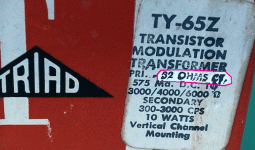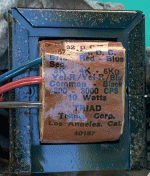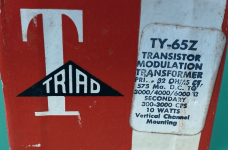Can I use a Modulation transformer as an Output transformer in a guitar amp?
I`m rebuilding a two 6L6 tube push pull bass amp and need an output transformer.
I currently have a vintage 1965 Hammond 2065 Modulation Transformer on hand: 60 Watts, 3800 ct Impedance, 200 sec Ma.
Could this transformer be used in this application?
I`m rebuilding a two 6L6 tube push pull bass amp and need an output transformer.
I currently have a vintage 1965 Hammond 2065 Modulation Transformer on hand: 60 Watts, 3800 ct Impedance, 200 sec Ma.
Could this transformer be used in this application?
An externally hosted image should be here but it was not working when we last tested it.
Hope this works...
Link is http://www.hammondmfg.com/pdf/Catalog%2065.pdf
So no that transformer won't suit as a typical audio amplifier output transformer as the secondary impedance is 3kohm. The 's.c. wdg' is a screen winding between primary and secondary windings.
I have a sort of similar 60W Woden UM2 with 5kPP primary. At least its secondary impedances are lower, but still not low enough for normal speaker use. The other aspect of a modulation transformer is that it typically has only a moderate low frequency response, as it primary inductance is fairly low.
So no that transformer won't suit as a typical audio amplifier output transformer as the secondary impedance is 3kohm. The 's.c. wdg' is a screen winding between primary and secondary windings.
I have a sort of similar 60W Woden UM2 with 5kPP primary. At least its secondary impedances are lower, but still not low enough for normal speaker use. The other aspect of a modulation transformer is that it typically has only a moderate low frequency response, as it primary inductance is fairly low.
With apologies for the "revival", the reading/research suggests that reverse driving a modulation-transformer (e.g. Hi-Z secondary made the primary, and Lo-Z side then matching the speakers) would work in a p-p... with minimal saturation concerns, lacking persistent DC current. My question is; what-about S-E operation?
That is, does an informed member of the forum happen to know if these modulation xformers are typically a gapped xformer design that could withstand a small amount of DC? I've been specificially researching a 10W TRIAD TY-65Z, but can find no reference to its laminations being gapped or not. I'm confident of its use in push-pull, but might just have to measure inductance with the introduction of DC current - once I get one - ...unless someone knows for sure! THX
That is, does an informed member of the forum happen to know if these modulation xformers are typically a gapped xformer design that could withstand a small amount of DC? I've been specificially researching a 10W TRIAD TY-65Z, but can find no reference to its laminations being gapped or not. I'm confident of its use in push-pull, but might just have to measure inductance with the introduction of DC current - once I get one - ...unless someone knows for sure! THX
Last edited:
If there is a DC current spec, it should be clear if it is gapped.
But the bandwidth is meager.
Jan
But the bandwidth is meager.
Jan
Attachments
Last edited:
Awesome catch! I'd not seen a good box decal to reference - yet belatedly realize that I neglected to check eBay for sellers' pix 🤔 ... Indeed, I anticipated minium fidelity/BW; fortunately it would be for a small guitar amp (likely no surprise there, I suspect), and connected to a "far-from-HiFi" loudspeaker.If there is a DC current spec, it should be clear if it is gapped.
But the bandwidth is meager.
Jan
I'll be sure to feed-back how the results turn out, and sincere thanks for the immediate response. Best regards.
Not sure about your so called "reading/research".With apologies for the "revival", the reading/research suggests that reverse driving a modulation-transformer (e.g. Hi-Z secondary made the primary, and Lo-Z side then matching the speakers) would work in a p-p...
No Lo-Z to be found anywhere in that transformer.
No speaker class Z anyway, they are always talking a couple KILO-ohms
No Lo-Z to be found anywhere in that transformer.
Link to your own post #7, Jan. The box picture clearly says 32 Ohms. Another image from eBay also says 32 Ohms.I would also like a link


And 8 Ohms is conveniently half of a 32r winding.
If you do math, you see that 10 Watts in 32 Ohms Center Tapped is 12.5 Volts Peak. Which tells you when and where. A car (small truck, boat, etc) in days when power audio transistors were practical, but RF had to be kept in tubes. That may cover much of a decade; I did not keep in touch with RF those days. Bottles probably lingered in civilian work after military apps moved to transistors for small and rugged. Clearly the 2nd image above is post-1963, and possibly several years later (Triad probably did not run a batch very often, would sell from inventory even without a ZIP code.)
Providing you desire accept the resticted band width, you can use it. No doubt. A modulation transformer isn't a rare case of transformer. You can use it reversed, using the high impedance to load a 6V6 for example, and load it with 4 inexpensive speakers 8Ohm in series. I am not musician, but I know that some instruments don't need large bw to operate properly, and some musicians seek some distortion and like it.
- Home
- Amplifiers
- Tubes / Valves
- Can I use a Modulation transformer as an Output?
